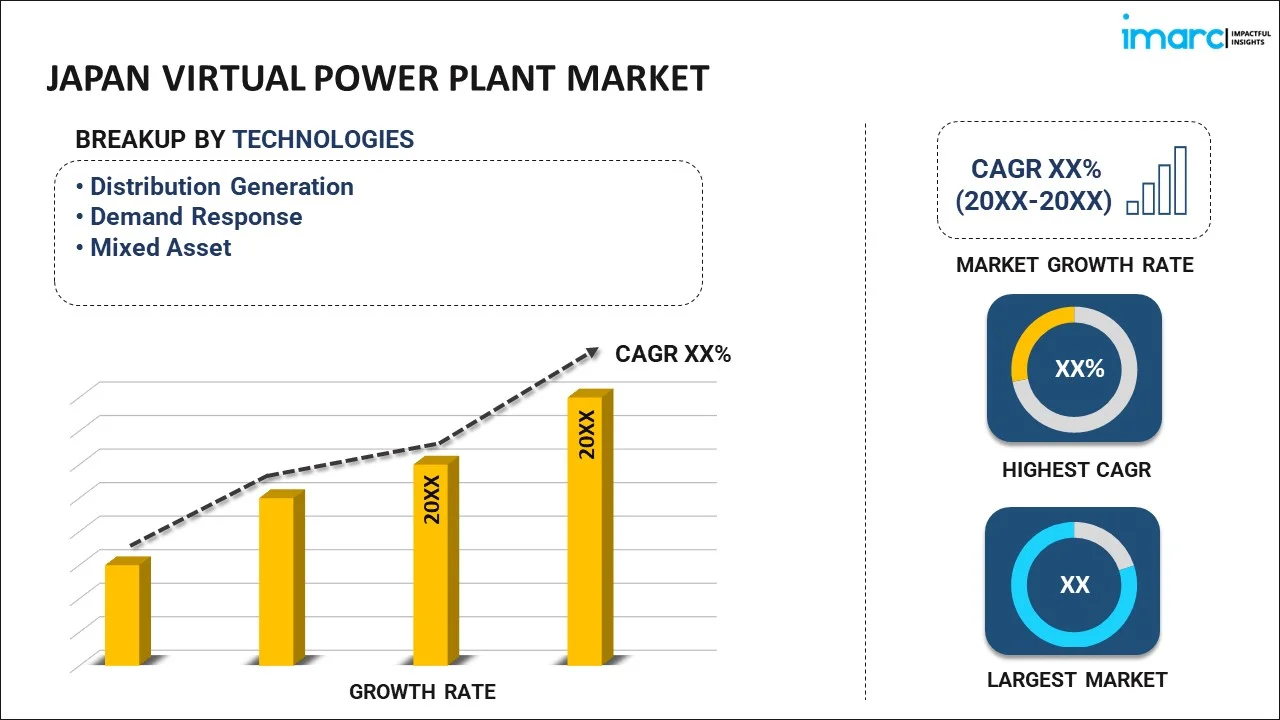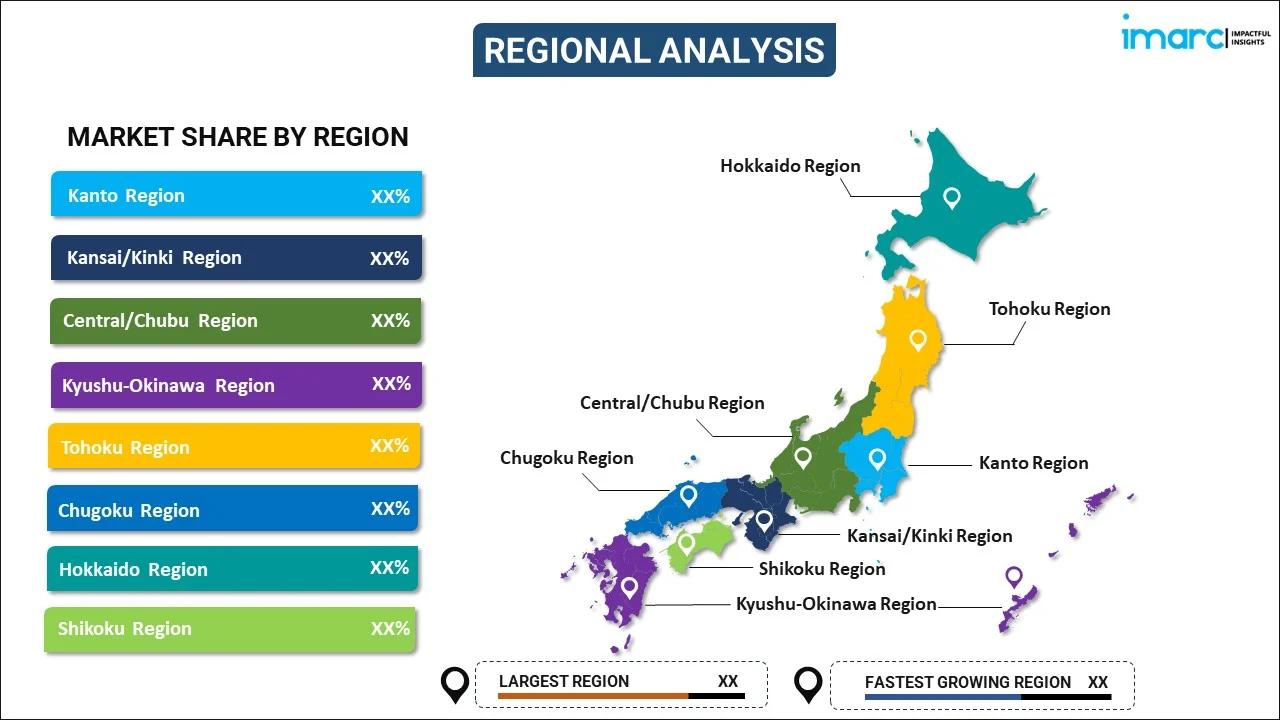
Japan Virtual Power Plant Market Report by Technology (Distribution Generation, Demand Response, Mixed Asset), End User (Industrial, Commercial, Residential), and Region 2025-2033
Market Overview:
Japan virtual power plant market size reached USD 120.9 Million in 2024. Looking forward, IMARC Group expects the market to reach USD 609.9 Million by 2033, exhibiting a growth rate (CAGR) of 18.72% during 2025-2033. The increasing application of energy storage technologies, such as batteries, which complement virtual power plants by enabling them to store excess energy during periods of low demand and release it when demand is high, is driving the market.
|
Report Attribute
|
Key Statistics
|
|---|---|
|
Base Year
|
2024 |
|
Forecast Years
|
2025-2033 |
|
Historical Years
|
2019-2024
|
| Market Size in 2024 | USD 120.9 Million |
| Market Forecast in 2033 | USD 609.9 Million |
| Market Growth Rate (2025-2033) | 18.72% |
A virtual power plant (VPP) is a sophisticated energy management system that harnesses the capabilities of various distributed energy resources (DERs) to function as a single, coordinated power generation and distribution entity. These resources can include solar panels, wind turbines, battery storage systems, and even demand response from consumers. Through advanced software and communication technologies, a VPP monitors and controls these DERs in real time, optimizing their operation for maximum efficiency and grid stability. It can dispatch surplus power to the grid when demand is high or store excess energy when demand is low. This dynamic approach helps balance the supply-demand equation, enhance grid reliability, and reduce greenhouse gas emissions. VPPs also offer benefits like cost savings for consumers, increased integration of renewable energy sources, and greater grid flexibility. They play a crucial role in the transition to a more sustainable and resilient energy system by efficiently managing decentralized energy resources and contributing to a cleaner, more reliable energy grid.
Japan Virtual Power Plant Market Trends:
The virtual power plant market in Japan is experiencing robust growth, driven by a confluence of factors. Firstly, the increasing integration of renewable energy sources into the power grid has fueled the demand for VPPs. As solar and wind energy generation can be intermittent, VPPs play a pivotal role in balancing supply and demand by aggregating these distributed resources. Furthermore, the growing emphasis on grid reliability and resilience has emerged as a key driver. VPPs offer grid operators enhanced flexibility and stability through their ability to quickly respond to fluctuations in power generation or demand. This capability becomes especially critical in regions prone to extreme weather events or other disruptions. Additionally, advances in technology have made VPP solutions more accessible and cost-effective. The advent of smart grid infrastructure, coupled with sophisticated data analytics and control systems, allows for efficient management and optimization of distributed energy assets. Apart from this, the increasing focus on sustainability and decarbonization efforts has spurred investments in VPPs as a means to reduce greenhouse gas emissions. Moreover, the proliferation of Internet of Things (IoT) devices and improved connectivity, which has enabled real-time monitoring and control of VPPs, thereby boosting their efficiency, is expected to drive the market in Japan.
Japan Virtual Power Plant Market Segmentation:
IMARC Group provides an analysis of the key trends in each segment of the market, along with forecasts at the country level for 2025-2033. Our report has categorized the market based on technology and end user.
Technology Insights:

- Distribution Generation
- Demand Response
- Mixed Asset
The report has provided a detailed breakup and analysis of the market based on the technology. This includes distribution generation, demand response, and mixed asset.
End User Insights:
- Industrial
- Commercial
- Residential
A detailed breakup and analysis of the market based on the end user have also been provided in the report. This includes industrial, commercial, and residential.
Regional Insights:

- Kanto Region
- Kansai/Kinki Region
- Central/ Chubu Region
- Kyushu-Okinawa Region
- Tohoku Region
- Chugoku Region
- Hokkaido Region
- Shikoku Region
The report has also provided a comprehensive analysis of all the major regional markets, which include Kanto Region, Kansai/Kinki Region, Central/ Chubu Region, Kyushu-Okinawa Region, Tohoku Region, Chugoku Region, Hokkaido Region, and Shikoku Region.
Competitive Landscape:
The market research report has also provided a comprehensive analysis of the competitive landscape. Competitive analysis such as market structure, key player positioning, top winning strategies, competitive dashboard, and company evaluation quadrant has been covered in the report. Also, detailed profiles of all major companies have been provided.
Japan Virtual Power Plant Market Report Coverage:
| Report Features | Details |
|---|---|
| Base Year of the Analysis | 2024 |
| Historical Period | 2019-2024 |
| Forecast Period | 2025-2033 |
| Units | Million USD |
| Scope of the Report | Exploration of Historical Trends and Market Outlook, Industry Catalysts and Challenges, Segment-Wise Historical and Future Market Assessment:
|
| Technologies Covered | Distribution Generation, Demand Response, Mixed Asset |
| End Users Covered | Industrial, Commercial, Residential |
| Regions Covered | Kanto Region, Kansai/Kinki Region, Central/ Chubu Region, Kyushu-Okinawa Region, Tohoku Region, Chugoku Region, Hokkaido Region, Shikoku Region |
| Customization Scope | 10% Free Customization |
| Post-Sale Analyst Support | 10-12 Weeks |
| Delivery Format | PDF and Excel through Email (We can also provide the editable version of the report in PPT/Word format on special request) |
Key Questions Answered in This Report:
- How has the Japan virtual power plant market performed so far and how will it perform in the coming years?
- What has been the impact of COVID-19 on the Japan virtual power plant market?
- What is the breakup of the Japan virtual power plant market on the basis of technology?
- What is the breakup of the Japan virtual power plant market on the basis of end user?
- What are the various stages in the value chain of the Japan virtual power plant market?
- What are the key driving factors and challenges in the Japan virtual power plant?
- What is the structure of the Japan virtual power plant market and who are the key players?
- What is the degree of competition in the Japan virtual power plant market?
Key Benefits for Stakeholders:
- IMARC’s industry report offers a comprehensive quantitative analysis of various market segments, historical and current market trends, market forecasts, and dynamics of the Japan virtual power plant market from 2019-2033.
- The research report provides the latest information on the market drivers, challenges, and opportunities in the Japan virtual power plant market.
- Porter's five forces analysis assist stakeholders in assessing the impact of new entrants, competitive rivalry, supplier power, buyer power, and the threat of substitution. It helps stakeholders to analyze the level of competition within the Japan virtual power plant industry and its attractiveness.
- Competitive landscape allows stakeholders to understand their competitive environment and provides an insight into the current positions of key players in the market.
Need more help?
- Speak to our experienced analysts for insights on the current market scenarios.
- Include additional segments and countries to customize the report as per your requirement.
- Gain an unparalleled competitive advantage in your domain by understanding how to utilize the report and positively impacting your operations and revenue.
- For further assistance, please connect with our analysts.
 Inquire Before Buying
Inquire Before Buying
 Speak to an Analyst
Speak to an Analyst
 Request Brochure
Request Brochure
 Request Customization
Request Customization




.webp)




.webp)












